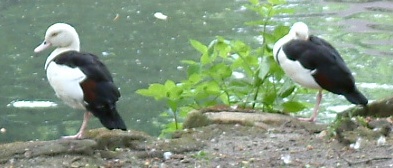- Radjah Shelduck
Taxobox
name = Radjah Shelduck
status = LC
status_system = IUCN3.1

regnum =Animal ia
phylum = Chordata
classis = Aves
ordo =Anseriformes
familia =Anatidae
genus = "Tadorna "
species = "T. radjah"
binomial = "Tadorna radjah"
binomial_authority = Lesson,1828
subdivision_ranks =Subspecies
subdivision =
* "T. r. radjah" (Black-backed Shelduck )
* "T. r. rufitergum" (Burdekin Duck )The Radjah Shelduck, "Tadorna radjah", (in
Australia also known as Burdekin Duck) is aspecies ofshelduck . Placed in thegenus "Tadorna", it differs markedly in external morphology, andmtDNA cytochrome "b" sequence data (Sraml "et al." 1996) suggests its status should be reinvestigated. The genus name "Tadorna" comes from Celtic roots and means "pied waterfowl", essentially the same as the English "shelduck".cite book| last =Kear| first =Janet| title =Ducks, Geese, and Swans| publisher =Oxford University Press| date =2005| pages =420| url =http://books.google.com/books?id=MfrdBcKd79wC&pg=RA1-PA439&lpg=RA1-PA439&dq=crested+shelduck&source=web&ots=RS734hgSmI&sig=006C0Hb6hpDK1aAEwu-ivfssJBk#PRA1-PA441,M1| isbn =0 19 861008 4 ]Both the male and female of the species are mostly white, with dark wingtips and a distinctive "collar" of dark
feather s. Seen from above in flight, the birds have green bands on the tops of their wings. The female has a harsh rattle and the male has a breathy, sore-throat whistle.The Radjah Shelduck inhabits the mangrove forests and coastline of
New Guinea and Australia. In Australia, its primaryrange is coastal tropical northern Australia, from centralQueensland through northernNorthern Territory (includingKakadu National Park ) to the Kimberley inWestern Australia .The species prefers the brackish waters of
mangrove flats andpaperbark tree swamps, but will visit freshwater swamps, lagoons, andbillabong s further inland during the wet season.The Radjah Shelduck forms long-term pair-bonds, and is usually encountered in lone pairs or small flocks. During the wet season the males commonly become very irritable, and have been observed attacking their mates.
The diet consists mainly of
mollusk s,insect s, sedge materials and algae. Pairs start searching for nesting sites during the months of January and February. They nest close to their primary food source, often in the hollow limbs of trees, which makeshabitat destruction a particular issue.Radjah Shelduck does not use nesting materials except for some self-supplied down feathers. Egg-laying is usually done by May or June, but depends on the extent of the
wet season . The clutches range from 6 to 12 eggs. Incubation time is about 30 days.The Radjah Shelduck is listed as a protected bird in all states of Australia and penalties exist for harming or disturbing them.
References
* Database entry includes justification for why this species is of least concern.
* Sraml, M.; Christidis, L.; Easteal, S.; Horn, P. & Collet, C. (1996): Molecular Relationships Within Australasian Waterfowl (Anseriformes). "Australian Journal of Zoology" 44(1): 47-58. DOI|10.1071/ZO9960047 (HTML abstract)
External links
* [http://www.birdlife.org/datazone/species/index.html?action=SpcHTMDetails.asp&sid=403&m=0 BirdLife Species Factsheet] . Retrieved 2006-DEC-02.
*Honolulu Zoo : [http://www.honoluluzoo.org/radjah_shelduck.htm Radjah Shelduck] . Retrieved 2006-DEC-02.
Wikimedia Foundation. 2010.
